6 ways to strengthen your healthcare organization’s financial health with locums
November 20, 2025
Healthcare systems that utilize locum tenens primarily as a short-term solution are missing out on key advantages that can strengthen the organization's overall financial health. Deployed strategically, locums can bolster healthcare finance by helping maximize revenue, maintain patient volumes, and reduce physician turnover and recruitment costs. Here are six ways that locums can serve as a valuable, long-term financial asset for healthcare organizations.
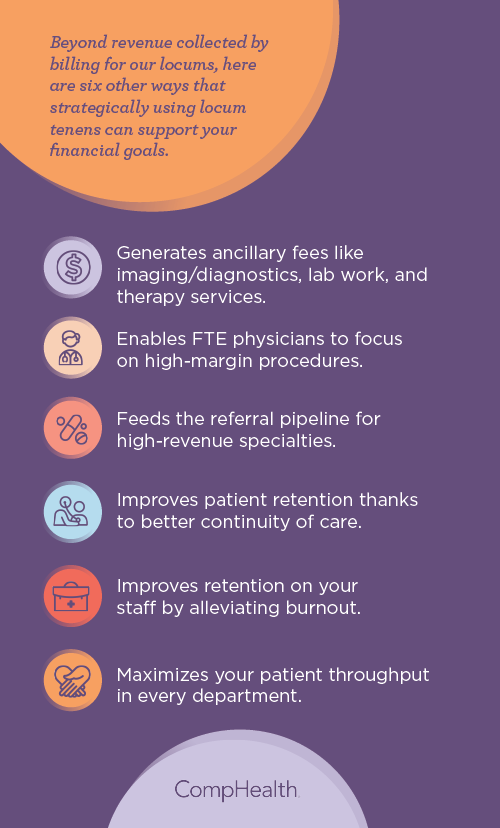
1. Locum tenens helps maintain ancillary revenue
Physicians are economic engines for healthcare systems, generating significant ancillary revenue beyond their own billed services. In fact, each office-based physician is linked to an average $3.1 million in economic output and supports an average of 17 jobs through patient care activities and referrals.
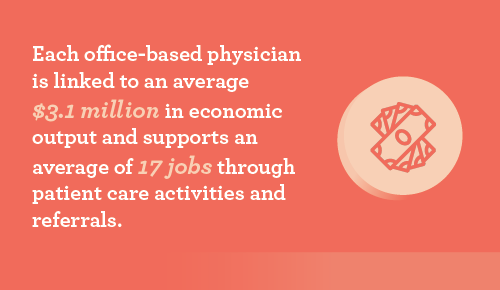
Physicians are often the primary point of contact for patients who require laboratory testing, diagnostic imaging, specialist referrals, and other healthcare services. Utilizing locum physicians to fill coverage gaps helps keep that economic activity buzzing, driving ancillary revenue far beyond the short-term cost of the locums placement.
2. Locums enables full-time physicians to focus on high-margin procedures
Locums can help maximize physician productivity by allowing permanent physicians to focus on high-margin procedures, thereby enhancing overall efficiency. Specialists perform diagnostic and surgical procedures that are billed at higher rates than routine consultations. With locum physicians absorbing the work of routine visits and lower-acuity cases, full-time specialists can devote their valuable time to higher-complexity, high-margin services and procedures.
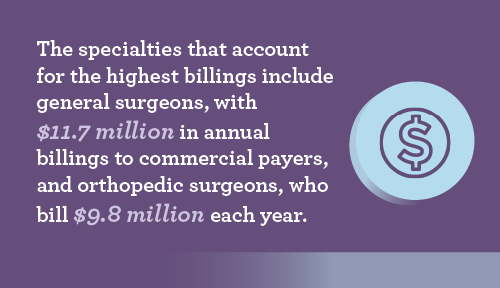
The specialties that account for the highest billings include general surgeons, with $11.7 million in annual billings to commercial payers, and orthopedic surgeons, who bill $9.8 million each year. On average, specialists bill $4.65 million annually. These billings represent a significant lost revenue opportunity when highly skilled specialists must spend their time on routine or consultative patient care.
Don't lose money on your locums: Learn how to bill for locum tenens services
3. Locums prevents referral leakage for high-revenue specialties
When specialist clinics are short-staffed, patients may become impatient with long wait times and seek care elsewhere, or referring physicians may send them outside the system. Referral leakage can result in up to 65% of referrals going out of network, representing a significant loss of revenue.
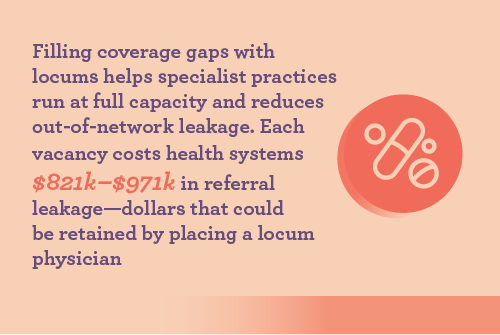
Filling coverage gaps with locum physicians helps specialist practices run at full capacity and reduces out-of-network leakage. Each physician vacancy costs health systems $821k–$971k in referral leakage—dollars that could be retained by placing a locum physician. Additionally, keeping patients in-network enhances the long-term value of the care relationship by preventing them from permanently switching to competitors.
Preventing referral leakage is even more crucial for the high-value specialties that accrue the greatest revenue. Orthopedics, for example, generates an average net revenue of $6,419 per case in ambulatory settings, while cardiology averages $4,611. Vacancies in these specialties leave a great deal of revenue on the sidelines.
How much revenue can you generate with locums?
Your inputs
Estimated cost results
Projected gross profit or loss
Gross ROI multiplier
Total billable charges*
Total locums investment*
4. Locums coverage improves patient retention
When a physician departs, the health system faces a heightened risk that patients will leave for a competitor, particularly if there is a break in coverage. According to an observational study of primary care within the Veterans Health Administration, patient experience ratings decline when a primary care provider leaves their position. After a physician's departure, 68.2% of patients gave a positive rating to the physician, compared with 74.6% before the departure.
This ratings reduction is an indication of patient displeasure with the disruption to their care and signals an increased risk of patient loss. Acquiring new patients costs at least five times as much as retaining existing patients, according to widely held industry estimates. Additionally, patient satisfaction scores are linked with reimbursement rates in value-based care models, so a drop in the score can lead to a financial hit for the health system.

Quickly filling vacancies with locum providers can ensure continuity of care, which will protect patient loyalty and bolster patient satisfaction scores.
5. Locums alleviates staff burnout and improves retention
Physician turnover and burnout are incredibly costly for healthcare organizations. According to commonly cited estimates, replacing a single physician due to burnout can cost anywhere from $500,000 to over $1 million, including lost revenue, recruitment costs, and onboarding expenses. In total, physician burnout costs the U.S. healthcare system an estimated $4.6 billion each year.
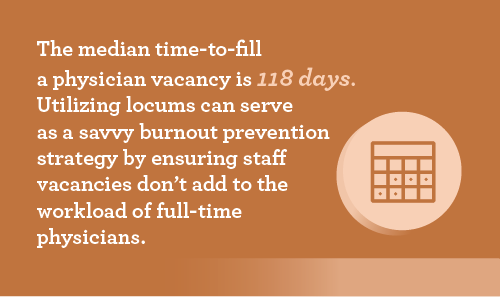
The median time-to-fill a physician vacancy is 118 days, which is a long time for colleagues to pick up the slack. Utilizing locum physicians can serve as a savvy burnout prevention strategy by ensuring staff vacancies don’t add to the workload of full-time physicians. At 7.3%, the physician turnover rate remains higher than pre-pandemic levels. Mitigating physician burnout with the strategic deployment of locum physicians is a practical way to reduce turnover and save on recruitment and related costs.
Boost your bottom line: 8 ways to reduce your days to fill
6. Locums maximizes patient throughput
Due to a persistent, ongoing physician shortage, physicians are working at or above capacity in busy, understaffed practices. In CHG Healthcare's 2025 Physician Sentiment Survey, physicians reported they work long hours, averaging 45 hours per week on scheduled shifts and an additional 15 hours on administrative tasks. These long work hours contribute to burnout, which affects nearly half of all physicians. Understaffing is one cause of the workload, with 26.5% of physicians saying that shortages of physicians and support staff contribute to their job-related stress.
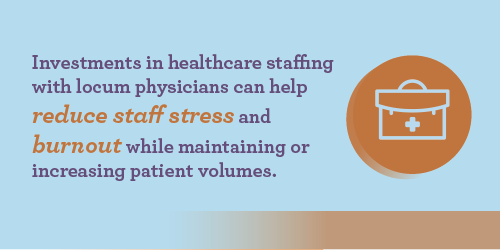
Investments in healthcare staffing with locum physicians can help reduce staff stress and burnout while maintaining or increasing patient volumes. Locum physicians can reduce average caseloads in busy practices or relieve pressure during times of peak demand. Locums enables full-time physicians to take much-needed time away from work without increasing their workload while they are gone. Deploying locum physicians can also enhance provider satisfaction by allowing highly skilled specialists to concentrate on their areas of expertise, rather than handling routine patient care.
Locums is more than just a cost center for healthcare systems. Locums is a healthcare staffing investment that protects and generates revenue streams, relieves the pressure on full-time physicians, and builds patient loyalty by enabling them to continue receiving high-quality care.
CompHealth specializes in finding the best physicians to help fill your staffing needs. Give us a call at 800.453.3030 or reach out online.